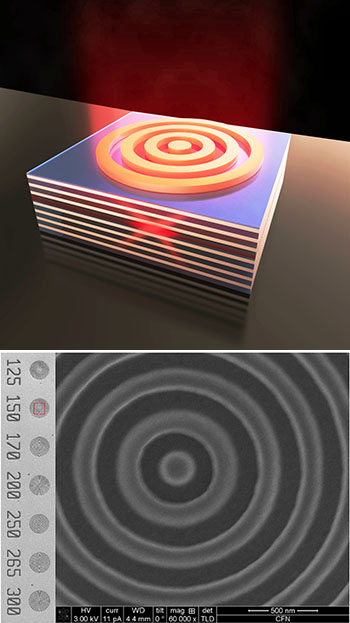
Artist’s rendering of stacked metamaterial with bullseye grating for coupling (top); SEM image of bullseye grating with 150 nm periodicity designed in the course of the study (bottom). [Images: Tal Galfsky, City College of New York; Galfsky et al., Optica, doi: 10.1364/OPTICA.2.000062]
Scientists in the United States and Canada, using embedded quantum dots and a novel bullseye grating, have fashioned a layered metamaterial from which spontaneously emitted light can be controlled and extracted at high efficiencies (Optica, doi: 10.1364/OPTICA.2.000062). The study’s authors believe that the properties of these “active hyperbolic metamaterials” could spur advances in a variety of photonic devices.
Hyperbolic metamaterials—human-engineered materials with a hyperbolic dispersion profile—have emerged as interesting candidates for a variety of photonic applications, particularly with embedded emitters such as quantum dots to locally excite high-momentum (high-k) electromagnetic states in the material. But there’s been a catch: coupling light out of these high-k modes has proved difficult, as the electric field becomes evanescent at the air-metamaterial interface.
To better couple the light from embedded emitters to the outside world, Tal Galfsky and colleagues at the City University of New York and Purdue University (USA) and the University of Alberta (Canada) devised a stacked structure of seven alternating layers of 20-nm-thick aluminum oxide (Al2O3) and 12-nm-thick silver, separated with 1-nm-thick slivers of germanium. Within the fifth Al2O3 layer they embedded a sublayer of quantum dots to serve as local emitters within the material. The layered metamaterial structure provided a roughly tenfold enhancement of the spontaneous emission rate from the quantum dots.
The team then used finite-element modeling to simulate the electric field within the structure, and to design an optimal grating that could couple to the evanescent field at the surface and pull the light out of the material. The optimal structure turned out to be a bullseye grating, which the team fashioned, at a variety of periodicities, from germanium. Adding the grating to the layered metamaterial led to as much as a twentyfold enhancement of light extraction from the embedded emitters compared with the material without the grating.
The team believes that the combination of characteristics in this system—control and enhancement of spontaneous emission, and a substantially better ability to extract that emitted light—could make these active metamaterials “an important step in achieving practical photonic devices such as subwavelength lasers, superluminescent LEDs, and single–photon sources.”
